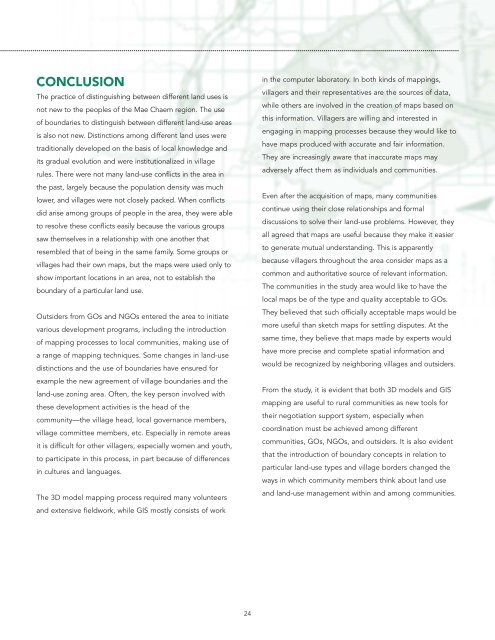FoxHershockMappingCommunities
FoxHershockMappingCommunities
FoxHershockMappingCommunities
Create successful ePaper yourself
Turn your PDF publications into a flip-book with our unique Google optimized e-Paper software.
CONCLUSION<br />
The practice of distinguishing between different land uses is<br />
not new to the peoples of the Mae Chaem region. The use<br />
of boundaries to distinguish between different land-use areas<br />
is also not new. Distinctions among different land uses were<br />
traditionally developed on the basis of local knowledge and<br />
its gradual evolution and were institutionalized in village<br />
rules. There were not many land-use conflicts in the area in<br />
the past, largely because the population density was much<br />
lower, and villages were not closely packed. When conflicts<br />
did arise among groups of people in the area, they were able<br />
to resolve these conflicts easily because the various groups<br />
saw themselves in a relationship with one another that<br />
resembled that of being in the same family. Some groups or<br />
villages had their own maps, but the maps were used only to<br />
show important locations in an area, not to establish the<br />
boundary of a particular land use.<br />
Outsiders from GOs and NGOs entered the area to initiate<br />
various development programs, including the introduction<br />
of mapping processes to local communities, making use of<br />
a range of mapping techniques. Some changes in land-use<br />
distinctions and the use of boundaries have ensured for<br />
example the new agreement of village boundaries and the<br />
land-use zoning area. Often, the key person involved with<br />
these development activities is the head of the<br />
community—the village head, local governance members,<br />
village committee members, etc. Especially in remote areas<br />
it is difficult for other villagers, especially women and youth,<br />
to participate in this process, in part because of differences<br />
in cultures and languages.<br />
The 3D model mapping process required many volunteers<br />
and extensive fieldwork, while GIS mostly consists of work<br />
in the computer laboratory. In both kinds of mappings,<br />
villagers and their representatives are the sources of data,<br />
while others are involved in the creation of maps based on<br />
this information. Villagers are willing and interested in<br />
engaging in mapping processes because they would like to<br />
have maps produced with accurate and fair information.<br />
They are increasingly aware that inaccurate maps may<br />
adversely affect them as individuals and communities.<br />
Even after the acquisition of maps, many communities<br />
continue using their close relationships and formal<br />
discussions to solve their land-use problems. However, they<br />
all agreed that maps are useful because they make it easier<br />
to generate mutual understanding. This is apparently<br />
because villagers throughout the area consider maps as a<br />
common and authoritative source of relevant information.<br />
The communities in the study area would like to have the<br />
local maps be of the type and quality acceptable to GOs.<br />
They believed that such officially acceptable maps would be<br />
more useful than sketch maps for settling disputes. At the<br />
same time, they believe that maps made by experts would<br />
have more precise and complete spatial information and<br />
would be recognized by neighboring villages and outsiders.<br />
From the study, it is evident that both 3D models and GIS<br />
mapping are useful to rural communities as new tools for<br />
their negotiation support system, especially when<br />
coordination must be achieved among different<br />
communities, GOs, NGOs, and outsiders. It is also evident<br />
that the introduction of boundary concepts in relation to<br />
particular land-use types and village borders changed the<br />
ways in which community members think about land use<br />
and land-use management within and among communities.<br />
24



